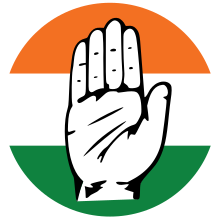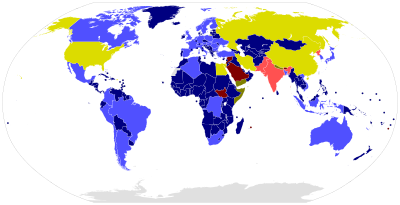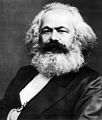Portal:Politics
| Main | Topics and categories | Tasks and projects |
The Politics portal
Politics (from Ancient Greek πολιτικά (politiká) 'affairs of the cities') is the set of activities that are associated with making decisions in groups, or other forms of power relations among individuals, such as the distribution of resources or status. The branch of social science that studies politics and government is referred to as political science.
It may be used positively in the context of a "political solution" which is compromising and non-violent, or descriptively as "the art or science of government", but also often carries a negative connotation. The concept has been defined in various ways, and different approaches have fundamentally differing views on whether it should be used extensively or in a limited way, empirically or normatively, and on whether conflict or co-operation is more essential to it.
A variety of methods are deployed in politics, which include promoting one's own political views among people, negotiation with other political subjects, making laws, and exercising internal and external force, including warfare against adversaries. Politics is exercised on a wide range of social levels, from clans and tribes of traditional societies, through modern local governments, companies and institutions up to sovereign states, to the international level.
In modern nation states, people often form political parties to represent their ideas. Members of a party often agree to take the same position on many issues and agree to support the same changes to law and the same leaders. An election is usually a competition between different parties.
A political system is a framework which defines acceptable political methods within a society. The history of political thought can be traced back to early antiquity, with seminal works such as Plato's Republic, Aristotle's Politics, Confucius's political manuscripts and Chanakya's Arthashastra. (Full article...)
Selected article
The Ordinances of 1311 were a series of regulations imposed upon King Edward II by the peerage and clergy of the Kingdom of England to restrict the power of the king. The twenty-one signatories of the Ordinances are referred to as the Lords Ordainers. English setbacks in the Scottish war, combined with perceived extortionate royal fiscal policies, set the background for the writing of the Ordinances in which the administrative prerogatives of the king were largely appropriated by a baronial council. The Ordinances reflect the Provisions of Oxford and the Provisions of Westminster from the late 1250s, but unlike the Provisions, the Ordinances featured a new concern with fiscal reform, specifically redirecting revenues from the king's household to the exchequer. Just as instrumental to their conception were other issues, particularly discontent with the king's favourite, Piers Gaveston, whom the barons subsequently banished from the realm. Edward II accepted the Ordinances only under coercion, and a long struggle for their repeal ensued that did not end until Thomas of Lancaster – the leader of the Ordainers – was executed in 1322.
Featured picture

The western (front) side of the United States Capitol. The U.S. Capitol serves as the location for Congress, the legislative branch of the U.S. federal government. It is located in Washington, D.C., on top of Capitol Hill at the east end of the National Mall. The building is marked by its central dome above a rotunda and two wings. It is an exemplar of the Neoclassical architecture style.
This article lists the heads of state of the Central African Republic. There have been seven heads of state of the Central African Republic and the Central African Empire since independence was obtained from the French on 13 August 1960. This list includes not only those persons who were sworn into office as President of the Central African Republic but also those who served as de facto heads of state.
Jean-Bédel Bokassa served as a de facto head of state (and also reigned as Emperor from 1976 to 1979), while David Dacko (who served as de facto head of state from 1979 to 1981), André Kolingba, Ange-Félix Patassé, and François Bozizé were elected into office at some point during their tenure. To date, Kolingba is the only former head of state of the Central African Republic to voluntarily step down from the office through a democratic process, following the 1993 general election. (Full article...)

Until the 18th century, Bombay consisted of seven islands separated by shallow sea. These seven islands were part of a larger archipelago in the Arabian sea, off the western coast of India. The date of city's founding is unclear—historians trace back urban settlement to the late 17th century after the British secured the seven islands from the Portuguese to establish a secure base in the region. The islands provided the British with a sheltered harbour for trade, in addition to a relatively sequestered location that reduced the chances of land-based attacks. Over the next two centuries, the British dominated the region, first securing the archipelago from the Portuguese, and later defeating the Marathas to secure the hinterland.
Bombay Presidency was one of the three Presidencies of British India; the other two being Madras Presidency, and Bengal Presidency. It was in the centre-west of the Indian subcontinent on the Arabian Sea. It was bordered to the north-west, north, and north-east by Baluchistan province, Punjab province, and Rajputana Agency; to the east by Central India Agency, the Central Provinces and Berar and Hyderabad State; and to the south by Madras Presidency and Mysore State. The Presidency was established in the late 17th century and named after Bombay, the capital city and the island on which it was built. By 1906, the area under the jurisdiction of Bombay Presidency stretched from North Canara in the south to Sindh in the north, encompassing the now-Pakistani province of Sindh, some parts of the present-day state of Gujarat, northwestern part of Karnataka state, the British Aden protectorate in Yemen, and the western two-thirds of modern-day Maharashtra. (Full article...)
Chief Mouser to the Cabinet Office is the title of the official resident cat at 10 Downing Street, the residence and executive office of the Prime Minister of the United Kingdom in London. There has been a resident cat in the British government employed as a mouser and pet since the 16th century, although modern records date only to the 1920s. Despite other cats having served Downing Street, the first one to be given the official title of chief mouser by the British government was Larry in 2011. Other cats have been given this title affectionately, usually by the British press. In 2004 a study found that voters' perceptions of the chief mouser were not completely above partisanship. (Full article...)

The Bharatiya Janata Party (BJP) is one of the two major parties in the political system of the Republic of India, the other being the Indian National Congress (INC). , it is the country's largest political party in terms of representation in the national parliament. Established in 1980, the BJP's platform is generally considered as the right-wing of the political spectrum. , 52 BJP leaders have held the position of a chief minister and Deputy Chief Minister out of which twelve and Eleven are incumbent.
A chief minister is the head of government of each of the twenty-eight states and three union territories (UTs) (Delhi, Jammu and Kashmir and Puducherry). According to the Constitution of India, at the state-level, the governor is de jure head, but de facto executive authority rests with the chief minister. Following elections to the state legislative assembly, the governor usually invites the party (or coalition) with a majority of seats to form the government. The governor appoints the chief minister, whose council of ministers are collectively responsible to the assembly. The chief minister's term is usually for a maximum of five years, with the confidence of the assembly's confidence. There are no limits to the number of terms the chief minister can serve. Deputy Chief Minister is a member of the state government and usually the second highest ranking executive officer of their state's council of ministers. While not a constitutional office, it seldom carries any specific powers.[1] A deputy chief minister usually also holds a cabinet portfolio such as home minister or finance minister. In the parliamentary system of government, the Chief Minister is treated as the "first among equals" in the cabinet; the position of deputy chief minister is used to bring political stability and strength within a coalition government. (Full article...)

The lifetime of British writer, philosopher, and feminist Mary Wollstonecraft (1759–1797) encompassed most of the second half of the eighteenth century, a time of great political and social upheaval throughout Europe and America: political reform movements in Britain gained strength, the American colonists successfully rebelled, and the French Revolution erupted. Wollstonecraft experienced only the headiest of these days, not living to see the end of the democratic revolution when Napoleon crowned himself emperor. Although Britain was still revelling in its mid-century imperial conquests and its triumph in the Seven Years' War, it was the French revolution that defined Wollstonecraft's generation. As poet Robert Southey later wrote: "few persons but those who have lived in it can conceive or comprehend what the memory of the French Revolution was, nor what a visionary world seemed to open upon those who were just entering it. Old things seemed passing away, and nothing was dreamt of but the regeneration of the human race."
Part of what made reform possible in Britain in the second half of the eighteenth century was the dramatic increase in publishing; books, periodicals, and pamphlets became much more widely available than they had been just a few decades earlier. This increase in available printed material helped facilitate the rise of the British middle class. Reacting against what they viewed as aristocratic decadence, the new professional middle classes (made prosperous through British manufacturing and trade), offered their own ethical code: reason, meritocracy, self-reliance, religious toleration, free inquiry, free enterprise, and hard work. They set these values against what they perceived as the superstition and unreason of the poor and the prejudices, censorship, and self-indulgence of the rich. They also helped establish what has come to be called the "cult of domesticity", which solidified gender roles for men and women. This new vision of society rested on the writings of Scottish Enlightenment philosophers such as Adam Smith, who had developed a theory of social progress founded on sympathy and sensibility. A partial critique of the rationalist Enlightenment, these theories promoted a combination of reason and feeling that enabled women to enter the public sphere because of their keen moral sense. Wollstonecraft's writings stand at the nexus of all of these changes. Her educational works, such as her children's book Original Stories from Real Life (1788), helped inculcate middle-class values, and her two Vindications, A Vindication of the Rights of Men (1790) and A Vindication of the Rights of Woman (1792), argue for the value of an educated, rational populace, specifically one that includes women. In her two novels, Mary: A Fiction and Maria: or, The Wrongs of Woman, she explores the ramifications of sensibility for women. (Full article...)
Selected quote
Selected biography
Gregory Richard Gianforte (/ˌdʒi.ənˈfɔːrteɪ/ JEE-ən-FOR-tay; born April 17, 1961) is an American businessman, politician, and software engineer serving as the 25th governor of Montana since 2021. A member of the Republican Party, Gianforte served as the U.S. representative for Montana's at-large congressional district from 2017 to 2021.
Did you know (auto-generated) -

- ... that despite entering politics as part of a right-wing party, Betty Tejada was later elected president of the Chamber of Deputies as a member of the Movement for Socialism?
- ... that in the 1916 Declaration of Sainte-Adresse Britain, France and Russia committed to securing the political and economic independence of Belgium after the First World War?
- ... that a year after becoming the first woman president of the Canadian Political Science Association, Caroline Andrew moderated the first Canadian leaders' debate on women's issues?
- ... that political philosophy professor Werner J. Dannhauser was the basis for a character in a Saul Bellow novel?
- ... that the historian and political journalist Lancelot Lawton addressed a House of Commons committee in London in 1935, beginning: "The chief problem in Europe to-day is the Ukrainian problem"?
- ... that reporter O. Kay Henderson, who has interviewed U.S. presidential candidates, is considered by national media to be an Iowa political authority?
More did you know...
- ...that the Japanese Farmer-Labour Party was banned just a few hours after its foundation in 1925?
- ...that Glenn Beck introduced a "Black-Robed Regiment" of pastors from various denominations during his Restoring Honor rally in 2010, and launched a news website called The Blaze three days later?
- ...that the book Targeted Killing in International Law argues support in the Western world for targeted killing increased following the September 11 attacks?
- ...that, at a congress in May 1921, all Socialist Party of Romania delegates who supported Bolshevik guidelines were arrested 24 hours after a vote on affiliation to the Comintern?
- ...that Ngo Dinh Diem became president of South Vietnam after a fraudulent 1955 election run by his brother Ngo Dinh Nhu, polling 133% of registered voters in Saigon?
- ...that the Brothers Grimm were amongst the Göttingen Seven, university teachers who protested changes to the constitution of the Kingdom of Hanover in 1837?
- ...that depending on a time and place, the same social movement may be revolutionary or not?
- ...that the 2013 United States federal budget may impose a 23% cut on the defense budget due to the Budget Control Act of 2011, according to Secretary of Defense Leon Panetta?
In this month
- May 5, 2005 – A General Election in the United Kingdom sees Tony Blair's Labour government returned to office with a reduced majority of 66.
- May 14, 1948 – The Declaration of Independence of Israel is made.
- May 18, 1948 – The first Legislative Yuan of the Republic of China officially convenes in Nanking.
News and Current events
- August 11: 4 local government areas in New South Wales, Australia locked down after COVID-19 case
- August 11: Australia: AstraZeneca vaccine access expanded by Victorian government
- August 1: Australia: Victorian lockdown lifted
- July 29: Tunisia's president dismisses prime minister, suspends parliament
- July 25: Australia: Wikinews interviews Reg Kidd, mayor of the City of Orange, about COVID-19 lockdown and local government
- July 23: South Australia enters week-long lockdown to contain COVID-19 Delta variant spread
- July 21: Technological University Dublin senior lecturer Dr Lorcan Sirr speaks to Wikinews on housing market in Ireland
- July 21: Three rural councils in New South Wales, Australia enter 7-day lockdown
- July 21: Australia: Victoria lockdown extended by a week with 85 active cases recorded
- July 15: California governor signs new state budget, eligible Californians to get stimulus payments
Topics and categories
General images
Related portals
Associated Wikimedia
The following Wikimedia Foundation sister projects provide more on this subject:
-
Commons
Free media repository -
Wikibooks
Free textbooks and manuals -
Wikidata
Free knowledge base -
Wikinews
Free-content news -
Wikiquote
Collection of quotations -
Wikisource
Free-content library -
Wikiversity
Free learning tools -
Wiktionary
Dictionary and thesaurus
Sources
More portals
- Portals with triaged subpages from June 2018
- All portals with triaged subpages
- All portals
- Portals with no named maintainer
- Random portal component with 41–50 available subpages
- Random portal component with 16–20 available image subpages
- Automated article-slideshow portals with 101–200 articles in article list
- Random portal component with 11–15 available subpages
- Random portal component with over 50 available subpages
- Politics portals
- Politics portal
- Politics



























































